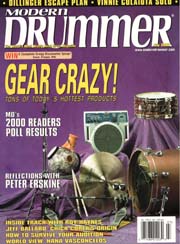Naná was the definition of a prolific contributor to the world of music and the music of the world. I met him on tour in Japan in the 1990s. He was an extremely warm guy. That much was clear from his persona on stage, and confirmed in person. This is a big, big loss...
Excerpt of an article from
Modern Drummer (July 2000) below. You'll need to re-read the first paragraph a few times to take it all in.
"Naná Vasconcelos: The Nature of Naná"By N. Scott Robinson
from
Modern Drummer 24, no. 7 (July 2000), 98-102, 104, 106, 108.
Naná Vasconcelos (Juvenal de Holanda e Vasconcelos), a percussionist with gifted creativity, was born in 1944 in Olinda, Pernambuco, Brazil and began a career in music over thirty-five years ago. In his early days in Brazil, he worked as a drumset player with Os Bossa Norte, Sambossa Trio, Yansã Quarteto, and Agostinho dos Santos and as a percussionist with Luíz Eça & Sagrada Família, Capiba, Quarteto Livre, Grupo Construção, Trio do Bagaco, Gilberto Gil, A Tribo, Os Mutantes, Gal Costa, Milton Nascimento, Raimundo Fagner, Teca Calanzas, Jards Macale, Caetano Veloso, Clementina de Jesus, Geraldo Vandre, and Geraldo Azevedo. Moving to France in the early-1970s, Naná continued developing creatively as a percussionist with Manduka de Mello, Mahjun, Jack Treese, Pierre Akendengue, Chic Streetman, Larry Martin, Jean-Roger Caussimon, David McNeil, Jacques Thollot, Baikida E. J. Carroll, and Jean-Luc Ponty. He first ventured into jazz with Gato Barbieri and developed concurrent recording careers in the USA, Europe, and Japan with jazz and pop artists Pat Metheny, Sergio Mendes, Chico Freeman, Chaka Khan, Talking Heads, Paul Simon, Jan Garbarek, Arild Andersen, Codona, Akiko Yano, Leon Thomas, Gary Thomas, Jack DeJohnette, Zbignew Seifert, Oliver Nelson, Andy Summers, Fredy Studer, Trilok Gurtu, Carly Simon, Mukai Shigeharo, Andy Sheppard, Woody Shaw, B. B. King, Masahiko Satoh, Ryuichi Sakamoto, David Sanborn, George Ohtsuka, Jim Pepper, Mara, Jon Hassell, Gipsy Kings, Don Cherry, and Egberto Gismonti. Endorsed by Paiste and Latin Percussion, first place winner of Down Beat’s prestigious Best Percussionist in the Annual International Jazz Critics Polls for nine consecutive years from 1983-1991, he has contributed to thirty-six film soundtracks, and has eleven recordings of his own music released to date.
Often describing his work as having a strong connection with nature, this became apparent when I met Naná in his Chelsea apartment in New York City where the air was filled with the smell of incense, exotic flowers and plants thrived in his living room where I was greeted by squirrels who darted in and out of the window stealing nuts from a bowl Naná leaves on a table for them. Although the phone rang constantly and studio technicians were coming and going through his apartment preparing equipment for mixing his latest CD, Contaminacão, Naná unhurriedly spoke of his career and of music itself with a child-like fascination . . .
NSR: Did you play drumset in your early days in Brazil?
NV: Yeah, I did, but before drumset I played percussion. I started playing bongos and maracas when I was twelve years old. I played in a cabaret in Recife, with my father. After that, I bought a drumset and played, then I came back to percussion. The reason why is because we had a lot of Latin music in Brazil before bossa nova like Cuban boleros, mambos, cha-cha-chá, and things like that. When bossa nova came, Brazilian music started to get a Brazilian identity. When I started playing percussion, we played a lot of Latin music, and when bossa nova came; my dream was to be a drumset player. I bought a drumset, and taught myself. I used to listen to the Voice of America radio show every night at seven o'clock. They had this program, . . . [hums, in blaring theme music fashion, Duke Ellington's "Take the A Train" while air drumming swing ride cymbal time]. I started listening to Dave Brubeck, Thelonious Monk, and Ornette Coleman playing his plastic saxophone, all those things. I used to go to the American Center [military base] in Recife to see some jazz there, and I got fascinated. I said, "I have to play drumset," and then I specialized in it. I played in 7/8 and 13/8, all these things. Different time signatures were not related to Afro-Brazilian rhythms, because these were rhythms of seven or thirteen. Everything in Brazil is 6/8, 4/4, or 2/4. I started to do those rhythms, and play Brazilian rhythms in those time signatures in the early 1960s in Recife. I played in the Yansã Quarteto, Os Bossa Norte, and the Sambossa Trio; I was the drumset player. These groups played what they called "bossa jazz."
Then I moved to Rio de Janeiro and met Milton Nascimento. When I had just met him, I said, "I came from Recife just to play with you." Because Milton was alone. Milton arrived in Rio de Janeiro at the same period that I arrived in the beginning of the 1960s. Nobody really understood his music because it was not bossa nova.
For me it was perfect, because drummers were only interested in playing bossa nova. I had a background playing percussion, I played congas, bongos, and things like that, and my uncle had candomblé in his house, and I knew the rhythms of the rituals well. Milton's group didn't need a drummer; he needed somebody to do rhythm that was not samba, that was not bossa nova. So I started working with Milton, and I got back to playing percussion, composing rhythms for his music.
. . .
[ Read
rest of the article on nscottrobinson.com ]


